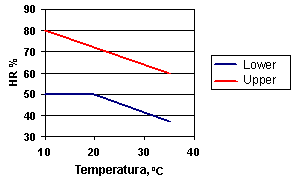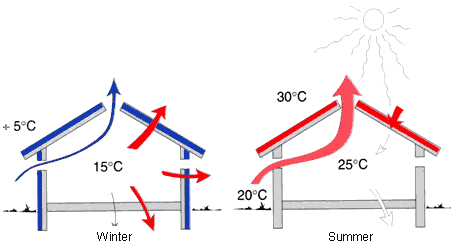Introduction
Modern pig buildings are complex structures with a high need of environmental control. The ventilation system is a central part of the accommodation, which must be integrated with the building to achieve an acceptable environment. Lack of control may lead to environmental failure and as a consequence abnormal behaviour such as tail biting or disease problems might arise.
All ventilation systems are based on the same principle, i.e., when cold outside air moves through a building it picks up moisture and heat. Moreover, it removes gasses and dust. The heat and water comes from the animals as well as other sources such as wet surfaces including slats and waste pits. In a winter situation the ventilation system mainly controls the moisture content of the air. Additional heat might be required for evaporation of water, increasing the water holding capacity of the air and/or for maintaining a proper ambient temperature.
A ventilation system will only work properly if the building is well-insulated and if it is free from leaks. Insulation is required to keep the building warm and to prevent condensation. Since the temperature and moisture content of the incoming air normally is lower than that of the inside it will pick up heat and moisture.
During warm weather the ventilation system primarily removes heat from the building. In addition, the ventilation system might serve as part of an artificial cooling system to protect animals from high temperature extremes.
The relative importance of the various factors that affect the indoor climate of a building varies greatly with the kind of animal being accommodated, the population density of the house, the quality of the building including insulation and the weather. This paper explains the most important principles of controlling the ambient temperature in pig buildings.

Temperature
The aim of the building and ventilation design is to maintain the ambient temperature within the thermoneutral zone of the animals, which extends from the lower critical temperature to the point where metabolic rate is actively reduced to heat stress – slightly below the upper critical temperature. In this zone the animal maintains its body temperature only by changing its behaviour or posture. Thus, its energy expenditure is kept at a minimum and its production rate is most efficient. Below the lower critical temperature the animal must increase its heat production rate to maintain body temperature either by metabolising body fat or by increasing feed intake. Above the thermo neutral zone the animal reduces its activity, increases breathing rate and reduces feed intake.
In animal accommodations the temperature sensor is an integral part of the ventilation system, which determines the ventilation rate and whether additional heat should be added. Modern ventilation systems might both have inside and outside sensors. The latter one measures the temperature of the incoming air and it aids in fine adjustment of the ventilation rate, e.g., if the outside temperature suddenly drops dramatically the outside sensor measures the change much faster than the inside one.
Table 1 is an example of how the thermoneutral zone is affected by various factors and Table 2 shows how the environmental temperature perceived by the animals changes at various conditions.
Table 1. Thermoneutral temperature of various kinds of pigs in a dry environment free from draughts.
| Category | Weight (kg) | Feed Intake (x maintenance) | Pigs/pen | Flooring | Thermoneutral Zone (ºC) |
| Piglets | 1 | 3 | 10 | Concrete | 26-32 |
| 1 | 3 | 10 | Straw | 20-27 | |
| 5 | 3 | 10 | Concrete | 22-30 | |
| 5 | 3 | 10 | Metal Slats | 20-29 | |
| 5 | 3 | 10 | Straw | 16-26 | |
| Weaners | 20 | 3 | 10 | Concrete | 16-28 |
| 20 | 3 | 10 | Straw | 11-25 | |
| Finishers | 40 | 3 | 15 | Concrete | 13-26 |
| 40 | 3 | 15 | Straw | 7-24 |
Table 2. Change in environmental temperature at various conditions as compared to dry bulb temperature.
| Environmental condition | Change in environmental temperature (ºC) |
| Air speed 0.2 m/s 0.5 m/s 1.6 m/s |
-4 -7 -10 |
| Flooring Straw Concrete slat Wet concrete |
+4 a +8 -5 -5 a -10 |
| Temperature difference (air-wall) 13ºC 3ºC 1ºC |
-7 -1.5 -0.5 |
The effective environmental temperature experienced by a 40 kg pig in a house with an air temperature of 18 degrees Celsius, an air speed of 0.5 m/s, a floor, which is wet and a reasonably insulated wall can be calculated as 18-7-5-1.5 = 4.5 C. According to table 1 this temperature is well below the thermoneutral zone and as a consequence the pig must increase its heat production by increasing energy intake or metabolising body fat to maintain homeostasis.
Relative humidity
The content of water vapour of the air is generally expressed by the relative humidity (RH). Pigs readily accept a wide range of humidity. The relative humidity is an indicator of the air quality since it depends on the heat and moisture balance of the accommodation. A dry environment affects the nasal mucosa of the pig negatively and increases the risk of air born infection. In a wet environment pathogens might be transferred via water droplet. Therefore, it is important that the relative humidity is kept within a certain range (Figure 1).

Figure 1. Recommended range of relative humidity with respect to ambient temperature.
Many ventilation systems have a moisture sensor as an integral part of the control system. It should be noted that moisture sensors are not as robust as temperature sensors. Therefore, malfunction of the ventilation system might be due to a defect moisture sensor, which usually results in excessive energy use – a problem that is often seen in hot nurseries. The sensor might easily be checked by a Kreiberg psychrometer.

Air distribution
The main function of a ventilation system is shown in Figure 2.

Figure 2. Winter ventilation (left) controls the moisture balance, while summer ventilation controls the heat load.




